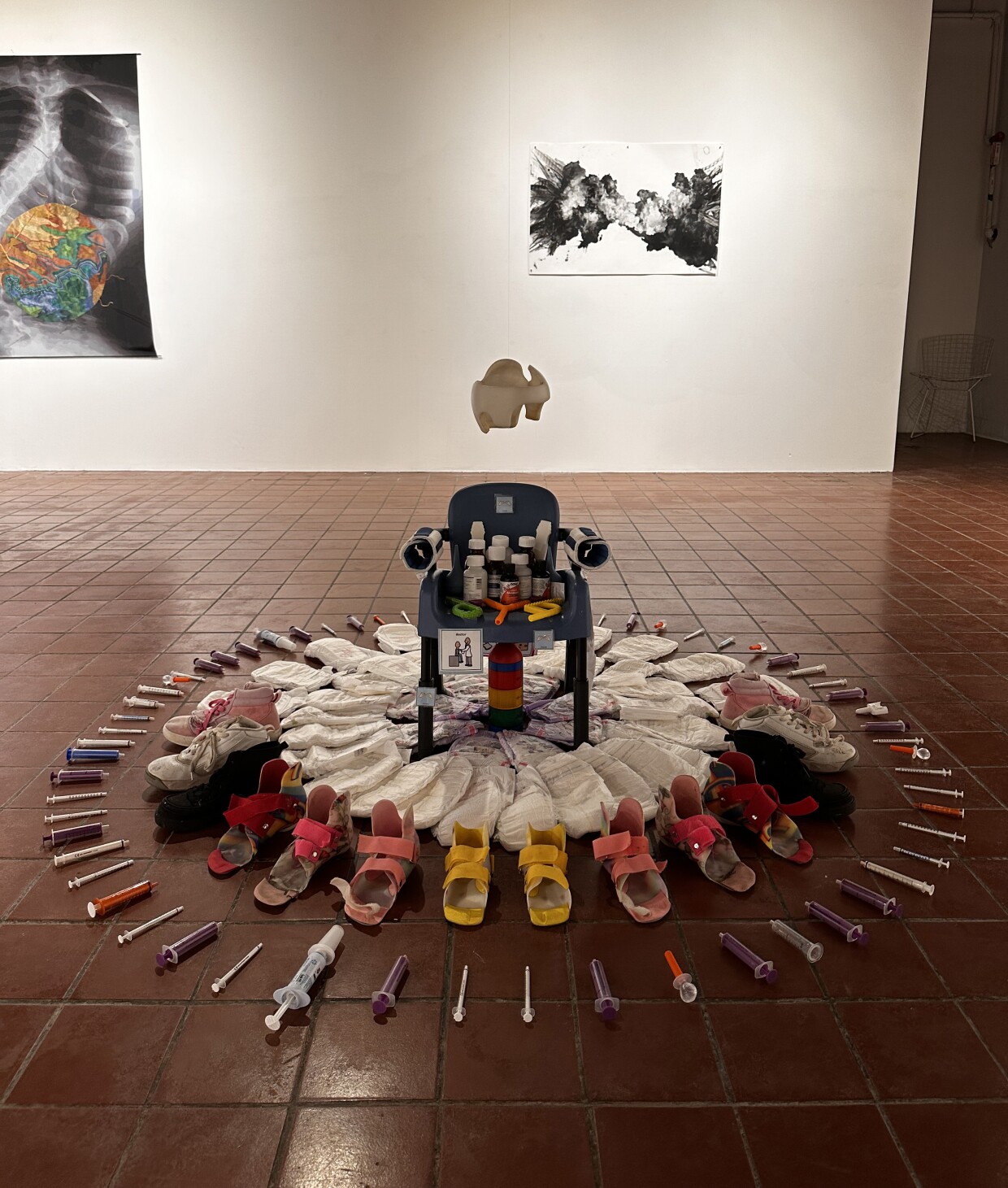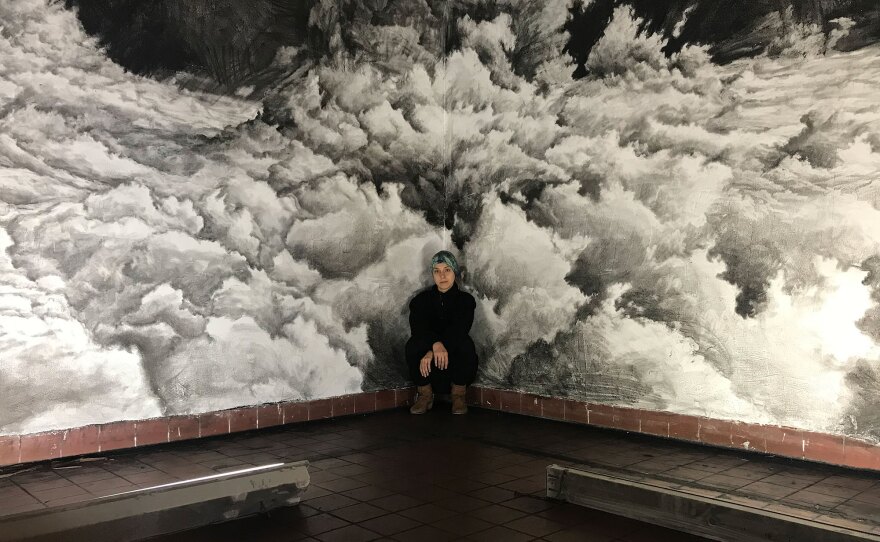Photographs of run-down settlements and dwellings in Tijuana set against the city's overwhelmingly blue sky.
Abstract sketches and cloud-like murals inspired by the physical complexity of time.
Immersive installations that restage archived moments from social and economic movements.
Current and upcoming exhibitions
Ingrid Hernández: '20 Años de Arte _Under Construction_'
Centro Cultural Tijuana (CECUT) El Cubo
Paseo de los Héroes 9350, Zona Urbana Río Tijuana
Tatiana Ortiz-Rubio at Bread & Salt
Coming February 2026
Danielle Dean at Storefront New York
Coming May 2026
San Diego Art Prize 2026 Exhibition at OMA
Coming Sept. 2026
As different as the work of the 2026 San Diego Art Prize winners are, artist Tatiana Ortiz-Rubio pointed out a big connection between herself and fellow recipients Ingrid Hernández and Danielle Dean.
"I am sharing this with two artists that I admire and respect very much, so that's very special for me. I also think it's quite important that we are three women working mothers, and I find that very meaningful today," Ortiz-Rubio said.
Established in 2006, the prize is a project of the San Diego Visual Arts Network and celebrates the border region's visual arts talent. For the winners, it means a cash award and a culminating exhibition — to be held next fall at the Oceanside Museum of Art.
And it offers something less tangible.
"For me, it means recognition — and recognition related to my work in Tijuana for all these 20 years," said Hernández.
The prize has evolved in recent years. Now, the judges are out-of-town curators representing major art institutions in cities around the world. It's a way of getting the word out about local artists.
Art scene fame is cyclical: The more outside institutions and collectors that discover an artist, the better it is for their career — which, in turn, adds to local prominence. That puts San Diego's art scene on the map.
Danielle Dean's social possibilities
Dean is curious about the way capitalism and social systems play out in archives and media.
" I look at a lot of archives — archives of advertising or archives of a particular event that's happened in history, or an archive of the history of a building. And I think about how those situations or that context or that history has a weighted influence on who we are — and, in particular, how we are living in a capitalist society," Dean said.
She wants to call attention to how unquestioning Americans can be about their systems.

"That is not the only way we could live, right? Capitalism is the social system that we are very much in, particularly in America. But I think America really poses it as it's the only possibility of a potential life that we could live," Dean said.
She works with video, performance and installation art, often combining all three — like in a recent project called "Amazon."

"You would walk in and it was a five-channel video installation. There were four monitors and one massive, large projection, and loads of props that look like plants to kind of make you feel like you were in the Amazon jungle. And you would see people on the screens who were sort of interacting with each other, but at the same time not — and it was very much about their isolated labor at home," Dean said.
It's inspired by Fordlandia, a work camp constructed in 1928 by Henry Ford in the Brazilian rainforest — a sort of rubber manufacturing utopia. Inhumane treatment and the incompatibility of American farming methods with the Amazon's landscape made that utopia unsustainable. It failed after just a few years.
Ingrid Hernández's Tijuana living spaces
Photographer Hernández explores Tijuana's unique — sometimes autonomous — housing communities.

"My work is related to the city of Tijuana and is focused on how people build their living spaces. Often they use materials discarded from maquiladoras — factories in Tijuana — and secondhand wood or plastic, or even rocks," Hernández said. " I'm very focused on the material aspect of their homes, not only because it's a phenomenon occurring on this border, but because I think that we can talk about many other issues related to the border and with the relationship that we have with this country."
She takes an embedded approach to her craft.
Some photos show structures from afar, askew on uncertain foundations, with pops of silvery tarp, concrete scraps and plywood. But it's the indoor photos that hint at her access, trust and intimacy. She's not just documenting — she's part of their story.

"I spend, at minimum, one year and a half, two years, three years. I have friends there and I am really interested in developing a relationship with the people there, because I think that that changed the way that I can see their spaces," she said.
Tatiana Ortiz-Rubio's reflections on time
Ortiz-Rubio's art is inspired by time — and care.
"I care-give for my daughter, who has complex disabilities, and in the underlying of my work, it has always been present — this idea of how someone with an intellectual disability experiences time differently. And I have lately been much more interested in what we call ‘crip time,’" Ortiz-Rubio said. "Crip time is the concept of revisiting history, revisiting our understanding of political, social, economic structures through the lens of disability or chronic illness."

When you rethink history and time that way, she said, it's disheartening.
"Sadly, it is completely based on what a productive body can offer to society," Ortiz-Rubio said.
Recently she created a "living installation" of medical equipment and chairs her daughter had grown out of and used medication bottles — a tangible representation of objects that, in her home, signify the passage of time.

"For us, they represent our whole story — our time, her time, her life in this world. They represent our hope. Also, some pain."
Ortiz-Rubio is also known for her cloud-like murals drawn with charcoal. For one — installed during a residency at Bread & Salt — she began work the day she got the call about her daughter's diagnosis.
She likened the feeling to flying through fog and clouds tangled in the mountains surrounding Mexico City, her hometown.

"You feel you're gonna land on this ocean of clouds; they feel almost thick. And then you cross through them and there's this vertigo. And I remembered that feeling for some reason when I was in there — and that's what I started drawing," Ortiz-Rubio said.
Common threads and what’s next
Despite the difference in process and form, the three women's work still feels cohesive: It deftly, sharply observes and questions what is right in front of us — what is real and what is possible.
Curator Lara Bullock, part of the San Diego Art Prize team, will work with the artists to put together their exhibit at OMA in September 2026. She said the artists explore similar ground.
"A throughline that I noticed is an exploration of boundaries — thinking of the border region again, but hegemonic confines that come about through like city, country, lived experience and how that affects the people within," Bullock said. "So I feel like the subject matter is really diverse, but there's like an interesting connection that will make the exhibition really exciting when it opens next year."





